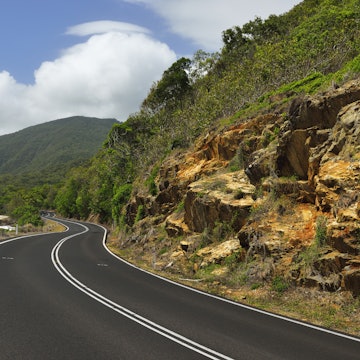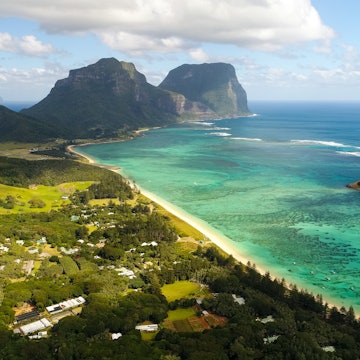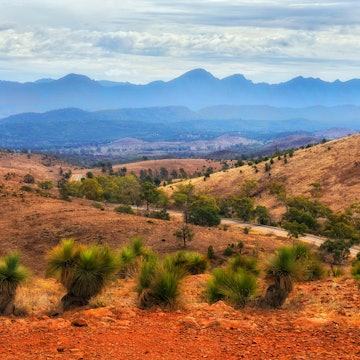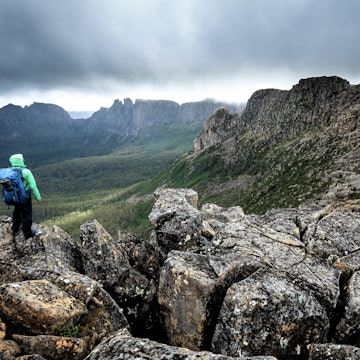

Kangaroos are a common sight on the beach at Lucky Bay in Western Australia. Getty Images
Undoubtedly one of Australia’s biggest draws is its wildlife, which you’re almost guaranteed to see amidst the nation's incredible landscapes (or in an animal sanctuary if you’re short on time). And despite the horror stories you may have heard, it's not all deadly spiders, sharks and snakes (although you may see all three if you stay long enough). The roll call of unique animals – from super cute mammals to colorful birds and fish plus lizards and geckos you won’t see anywhere else – is long.
Australia offers many different wildlife-spotting experiences, depending on where you visit. However, some of even its most famous species are critically endangered, which means sightings are rare and conservation efforts are vital.
We've created the ultimate beginner’s guide that gives you the best chance of getting up close (but not so close that you put these wild creatures at risk) with Australia’s unique native animals.
Where are the best places for wildlife watching in Australia?
Your best chance of spying some Australian fauna will be in one of the 500+ national parks scattered across the country.
Some national parks are better set up for overseas visitors, with accommodation nearby and guides available for a wildlife-spotting tour. In the north, head to The Daintree (Queensland), Kakadu National Park (Northern Territory) or Cape Range National Park (Western Australia). In the southern states, put the Blue Mountains (New South Wales), Grampians (Gariwerd) National Park in Victoria and Cradle Mountain-Lake St Clair National Park in Tasmania on your must-visit list.
Many rural accommodations in Australia are embedded in nature, which means you may have emus, echidnas or wallabies wandering past your room.
But even a city-based trip Down Under offers opportunities for close-up wildlife encounters. Kangaroos inhabit the capital city of Canberra, koalas live in the Adelaide Hills, and the one-of-a-kind quokka is found on Wadjemup/Rottnest Island near Perth – and where do we begin with the birdlife in Sydney? If you want to see unique animals, you’ve come to the right place.

Where are the best places in Australia to see koalas, kangaroos and other iconic species?
Koalas
Koalas need no introduction. The poster child for “super cute Australian animals,” koalas spend around 20 hours a day fast asleep. If you’re going to see a koala on the move, clumsily crabbing along the ground from one tree to the next, it’s most likely at night. Otherwise, they’re usually perched in the crook of a tree munching on eucalyptus leaves alone or with a joey clinging on. You can spot these adorable tufty-eared marsupials in forests close to the coast in southeastern Australia. However, human encroachment has put koalas on the endangered list in NSW, the Australian Capital Territory and Queensland.
Where to find them: Stands of trees along the Great Ocean Road (Victoria), on Magnetic Island and Stradbroke Island/Minjerribah (Queensland), and on Kangaroo Island (South Australia) are known by locals to house koalas – you’ll have to ask around. Some wildlife parks allow visitors to take a photo with a koala, but cuddling one is a controversial practice that’s illegal in most states because it causes stress to the animals.
Tips for spotting them: Koalas are noise-sensitive – a quiet approach through the forest is required. If you look carefully at higher branches (binoculars may help), you may spot one attached to a tree limb. You’ll find it easier to spot one if they’re munching or moving around so try early in the morning or at dusk when it’s cooler.

Kangaroos and wallabies
First, how do you know which is which? Both kangaroos and wallabies are marsupials that belong to a small group of animals called macropods (yes, that’s Latin for “big feet”). Kangaroos are larger; they’re usually one color; they use their tails like a fifth foot (which also means they jump further); and are often bounding through open grasslands. Wallabies, on the other hand, are smaller (25kg compared to a 90kg kangaroo) and their color can vary, like the black-footed rock wallaby, which helps them camouflage in forests or on rocky escarpments where they typically live.
Where to find them: Kangaroos live in many parts of Australia, they’re even been spotted on suburban streets and golf courses at dusk. One of the most iconic places to see kangaroos is on the white-sand beaches of Lucky Bay in Cape Le Grand National Park (Western Australia). Wallabies can be shier and they stick to smaller groups, but different species are found in national parks such as Narawntapu National Park (Tasmania) and Cape Hillsborough National Park (Queensland).
Tips for spotting them: Dawn and dusk are the best times to see kangaroos and wallabies. Don’t make any sudden moves, as they spook easily. And if you do get close, definitely don’t feed them.

Wombats
Perhaps not as well known outside Australia, wombats are beloved by locals. They feature in Aboriginal Dreaming stories, as well as classic Australian children’s literature. The word "wombat" is believed to come from the Dharug language of the Aboriginal people, the Traditional Custodians of the Sydney area (as does koala and wallaby). These gentle furry marsupials are around as big as a medium-sized dog – but with smaller legs and a stout body – and they hide out in burrows by day, foraging for food by night. A classic piece of pub quiz trivia is the fact wombat poo is cube-shaped. If you see some, you know one is close.
Where to find them: The best places to spot wombats include the Bay of Fires, Cradle Mountain-Lake St Clair National Park, and Flinders or Maria islands (Tasmania); Wilsons Promontory National Park (Victoria) and the Blue Mountains (NSW). Unfortunately, the northern hairy-nosed wombat is critically endangered – only a small population of around 300 remains in a protected area of Queensland.
Tips for spotting them: Dawn and dusk are your best times to spot wombats, as they hibernate during the heat of the day, but if you’re camping at a national park you may see (or hear) them out overnight.

Echidnas
You’ll bump into these short-beaked spiny creatures in national parks but even in bushland areas close to the city. Those sharp-looking spines, which protect echidnas from predators like birds of prey and larger mammals, are actually hairs with extra keratin. When frightened, an echidna will tuck its snout and legs under and curl into a spiky ball. Even though they look similar, echidnas have more in common with the platypus (another egg-laying mammal in Australia, read on!) than the common hedgehog. And here’s another cute fact: a baby echidna is called a “puggle”.
Where to find them: You’ve got a good chance of seeing an echidna in southern states like Victoria, NSW, South Australia, ACT, Tasmania and southwest WA, where there’s plenty of forests, shrubland and insects for them to live on.
Tips for spotting them: In summer echidnas are out foraging around dawn and dusk, but in cooler seasons you may spot one in the day. They’re shy, slow-moving creatures so keep still if one waddles into your path – it will change course if it hears you. Small holes in the ground are often a sign an echidna has been foraging for ants and termites nearby.
Crocodiles
Two types of crocodiles live in tropical Australia: saltwater and freshwater crocs. “Salties,” as Australians call them, are found in estuaries and rivers by the coast as well as in the sea. Male saltwater crocodiles can grow to 6-7 meters (20ft to 23ft) although most are closer to 4 meters (13ft). “Freshies” are smaller (2m/6.5ft) and less aggressive, but if they’re feeling threatened, their bite is dangerous.
Crocodiles were hunted in Australia until the 1970s when they became a protected species. A direct encounter with a crocodile will likely kill you, so follow all instructions from your guide. Never – ever – enter a body of water in northern Australia unless you are absolutely sure it is crocodile-free, and read up on staying safe in crocodile regions.
Where to find them: Crocodiles live in the northern parts of Australia. To see saltwater crocodiles in the wild head to Adelaide River and Kakadu National Park (Northern Territory) and the Daintree River (Queensland). Freshwater crocodiles can be seen at Nitmiluk (Katherine Gorge) and Litchfield national parks (Northern Territory), plus Lake Argyle and Bandilngan (Windjana Gorge) National Park in Western Australia.
Tips for spotting them: The dry season (May to October) is the best time to see crocs as they’ll be concentrated near water sources or basking in the sun on a river bank. They can be hard to spot in water as they usually float with only their eyes and snout breaching the surface. Look for slide marks on river banks or a distinctive V-shaped wake in water.

Emus
These large flightless birds (second only to the ostrich) live in various spots across Australia except in Tasmania. They are often running along wide open plains in search of food and water, and avoiding predators (they can reach speeds of 50kph/30mph). For many Aboriginal Australians, the emu has an important role in mythologies and is a key creator spirit. Look up and you will see the Emu in the Sky, a constellation made of the dark areas of the Milky Way.
Where to find them: You’ll find emus on grassy plains in Kosciuszko National Park (NSW), on open savanna in Murray Sunset National Park (Victoria) and in many outback regions. As they are not aggressive animals, they also often inhabit city-based wildlife parks.
Tips for spotting them: Emus can be seen in groups if there’s a water source nearby, but you may spot one on its own. In areas where there are lots of tourists they may have been hand-fed which can make them more aggressive, particularly about getting food – always keep your distance. As a child, this animal lover was nipped by one at Healesville Sanctuary (which was more of a shock than anything else).
Tasmanian Devils
You know the Looney Tunes cartoon character Taz, the Tasmanian Devil? Well, these cute carnivorous marsupials are also endangered, due to the fatal and transmissible Devil Facial Tumor Disease (DFTD) that has killed 80% of the population. A disease-free colony has been established on Maria Island (off the Tasmanian mainland) and scientists have been testing a vaccine inspired by the way the SARS-CoV-2 vaccine works.
Where to find them: Tasmanian Devils have been spotted at Cradle Mountain-Lake St Clair National Park, Narawntapu National Park and Mount William National Park, but you’re more likely to see one in a wildlife park in a special nocturnal exhibit where you will also learn more about Tasmania’s conservation efforts.
Tips for spotting them: Tasmanian Devils are nocturnal scavengers (they will munch through carrion from the side of a road, with a bite as strong as a hyena) so be careful driving after dark. Going on a guided nighttime tour will increase your chances of seeing one in the wild.
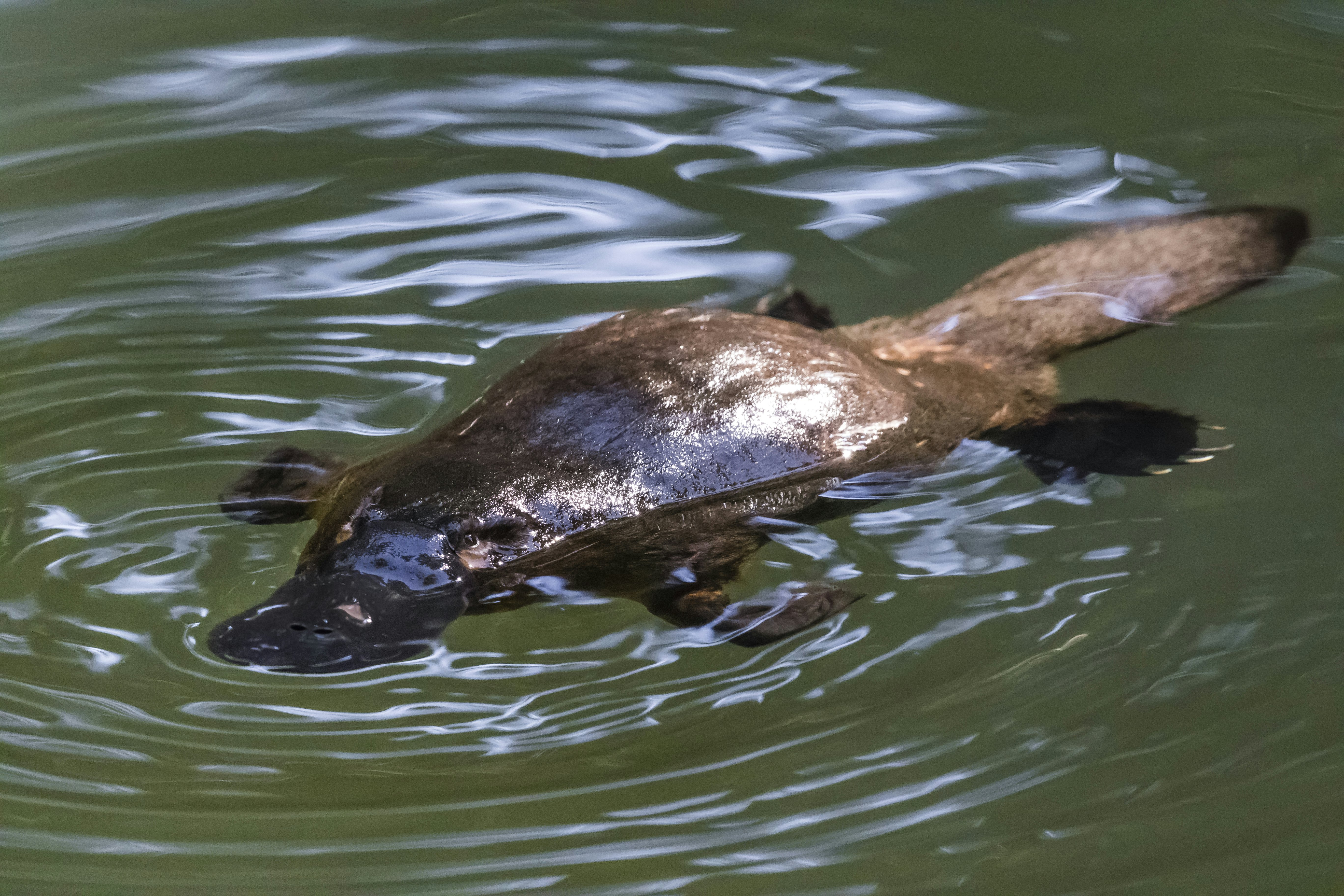
Platypus
Their reputation for the unexpected precedes them. In the 19th century, naturalists back in England thought a platypus specimen must be a hoax with its duck-like bill, otter-like body, beaver-like tail, webbed feet, sharp claws and venomous spurs. This egg-laying mammal is unique to Australia, and while seeing one in the wild will take patience and luck, they are real. Apart from admiring their representation on Australia's 20c coin, many zoos and wildlife parks have nocturnal platypus enclosures where you can view them burrowing and swimming underwater.
Where to find them: The Atherton Tablelands is the most iconic spot for platypus sightings – ask at a local tourist office for recommended spots. In Eungella National Park, special viewing platforms have been integrated into the forest around Broken River, one of this elusive monotreme’s favorite habitats.
Tips for spotting them: Patience is the key – set yourself up quietly and comfortably and look for telltale trails of bubbles on the water’s surface. Chances are the bubbles will be followed by a surfacing platypus. Don’t startle them – platypuses are notoriously shy and will dive back underwater in the twinkling of an eye and take refuge in a riverside burrow if they sense danger.

Quokkas
These marsupials are so photogenic that the “quokka selfie” became an online trend – until animal welfare experts spoke up. These small wallaby-like marsupials may look like they’re happy but that smile is really a quirk of the quokka’s facial structure, not permission to put a camera in their face. Quokkas are non-aggressive – docile even – which adds to the anthropomorphizing by humans. They also climb trees, hop like rabbits and sleep in the daytime. Quokkas are listed as "vulnerable" due to habitat loss as well as the arrival of predators (humans shamefully were on that list).
Where to find them: Quokkas are found on Wadjemup/Rottnest Island in Western Australia, a 30-minute ferry journey from Fremantle south of Perth.
Tips for spotting them: Quokkas are nocturnal, although in the winter months, they can be active during daylight hours. Get away from other tourists by foot or bike to increase your opportunity for a chance encounter, or book a guided walking tour. The Rottnest Voluntary Guides Association runs a “Meet the Quokkas” walking tour daily, where visitors are asked to observe from a respectful distance.
For visitors short on time, consider visiting a wildlife sanctuary
Sightings are never guaranteed when you’re dealing with wildlife, so if your trip Down Under won't be complete without a koala, there are myriad wildlife reserves and zoos in Australia where native (and non-native) animals are in residence.
Yes, there’s a strong animal welfare case for never visiting animals in captivity, but many in Australia do adhere to strict animal welfare protocols and contribute to education and conservation efforts (do your research and you can be the judge).









